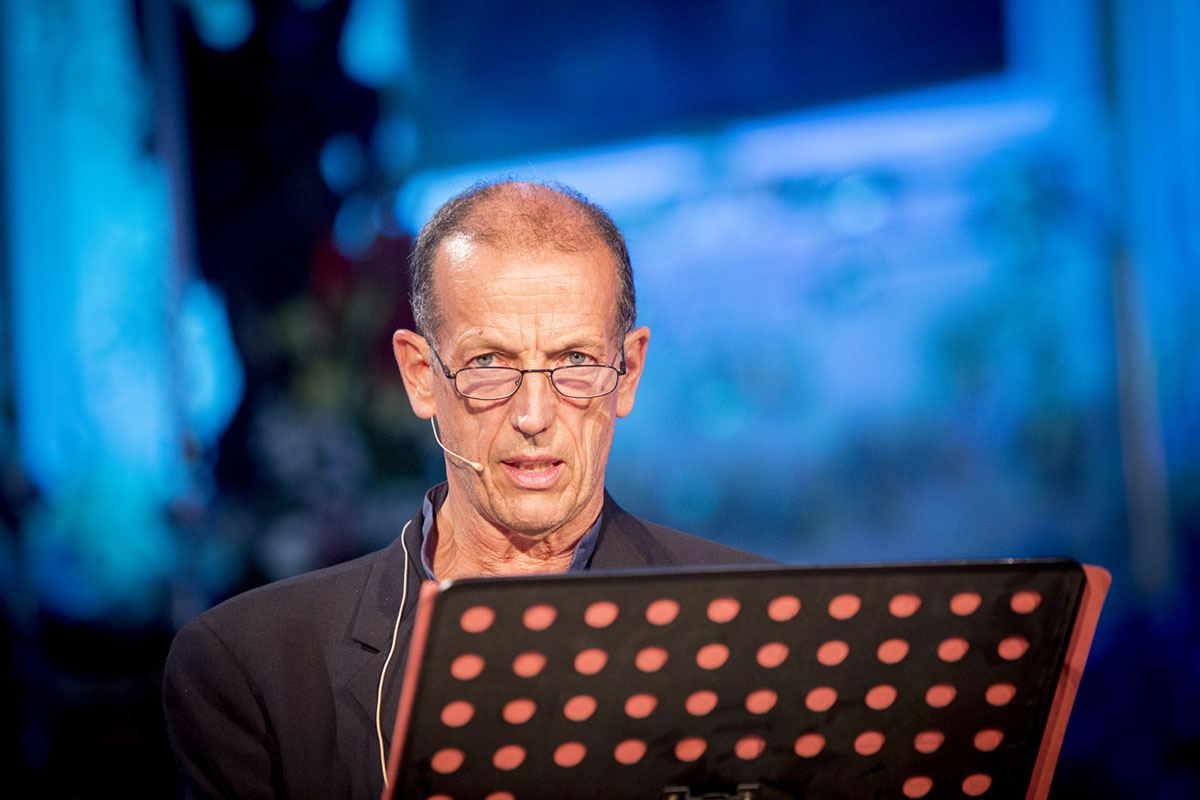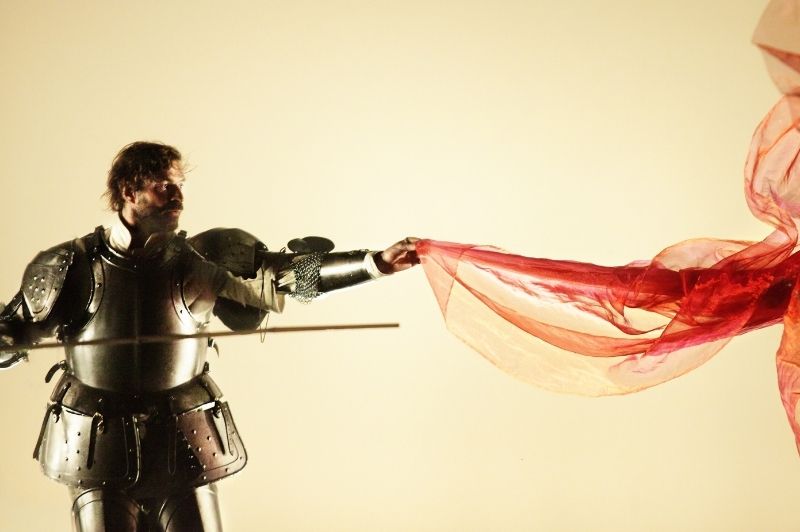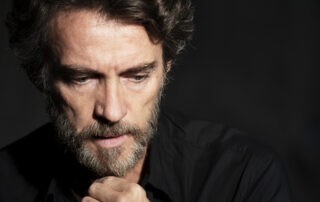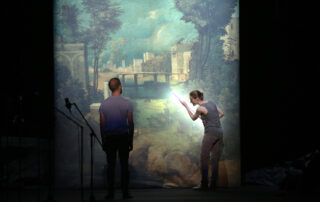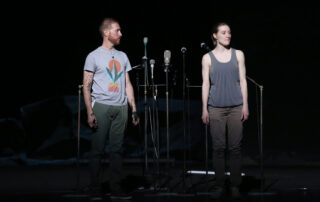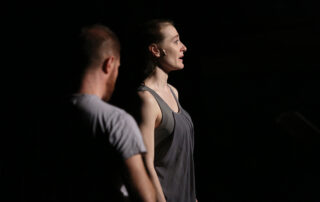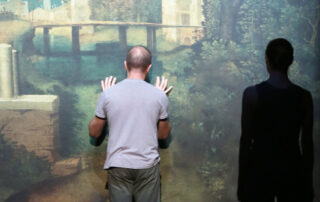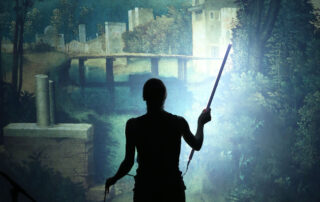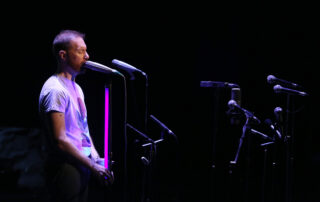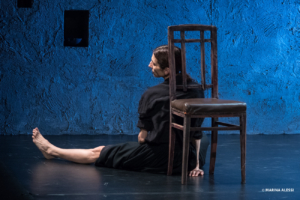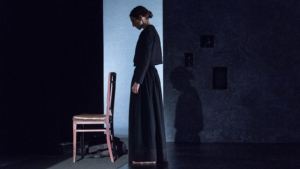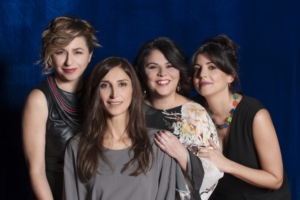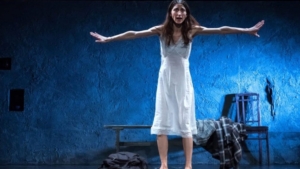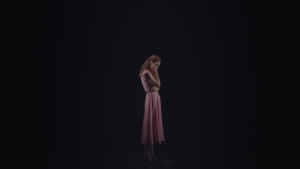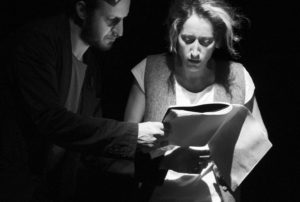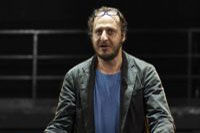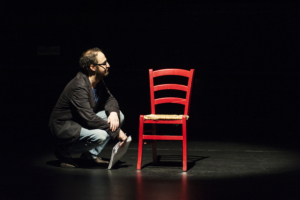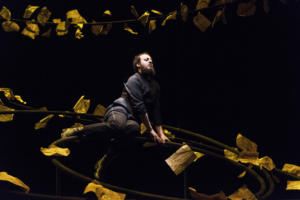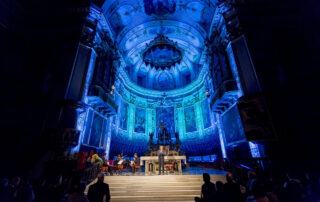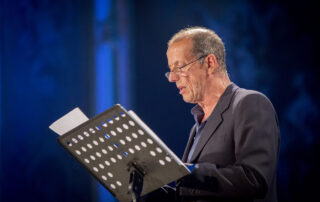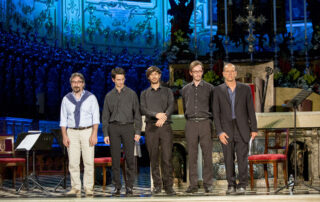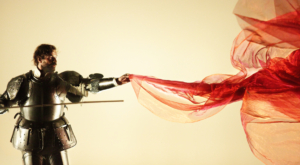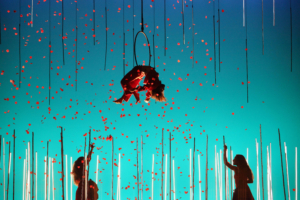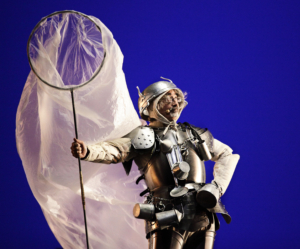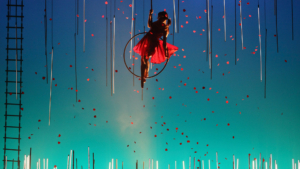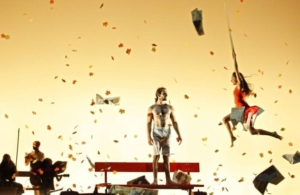PROSE PRODUCTIONS AND ALTRI PERCORSI
In the 2016/2017 Season, the Donizetti Theater Foundation began its production in the area of prose.
These are carefully conceived, designed and produced shows together with co-producers with whom the Foundation has shared passion and artistic choices for years.
ILIADE Il gioco degli déi
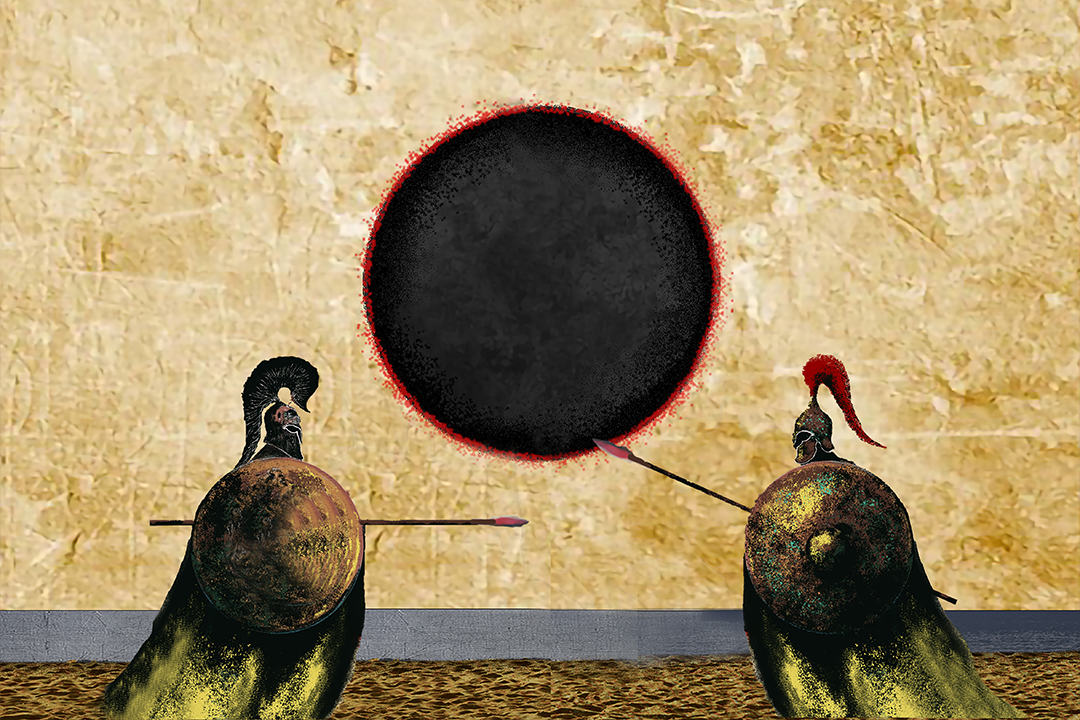
text by Francesco Niccolini
freely inspired by Homer ‘s Iliad
dramaturgy by Roberto Aldorasi, Alessio Boni, Francesco Niccolini and MarcelloPrayer
directed by Roberto Aldorasi, Alessio Boni, Marcello Prayer
with Alessio Boni, Iaia Forte
and with (in o.a.) Haroun Fall, Jun Ichikawa, Francesco Meoni, Elena Nico, Marcello Prayer e Elena Vanni
scenes Massimo Troncanetti
costumes Francesco Esposito
lighting design Davide Scognamiglio
music Francesco Forni
creatures and props Alberto Favretto, Marta Montevecchi, Raquel Silva
production New Theater directed by Marco Balsamo
in co-production with Donizetti Theater Foundation of Bergamo, Teatro della Toscana Foundation e Teatro Stabile del Friuli Venezia Giulia
They are the cause of everything, but they are not to blame for anything, capricious, vindictive, inhuman: they are the immortal gods, and their comedy has been the tragedy of men since time immemorial. For some time now, however, something has changed: they have become pale, faded images of their ancient splendor, they have lost their powers, and they cannot explain how or when their waning began. They have not met each other for centuries, since the time of Helen, Achilles, Hector, Andromache, Priam, Hecuba, Agamemnon, Patroclus, Odysseus and the other characters whose destinies they enjoyed, but today a mysterious invitation brings them all together,
after so long. Who invited them? For what reason?
Ten years after I Duellanti and Don Quixote, the Quadrivio, formed by Roberto Aldorasi, Alessio Boni, Francesco Niccolini and Marcello Prayer, rewrites and stages theIliad to mirror the oldest myths of Western poetry and the war of all wars.
So it is again the great classical literature that attracts the artist, who was highly praised last season for his ironic and humane rereading of Cervantes’ Don Quixote. Focusing on the Trojan War, theIliad offers Boni and his group an opportunity to observe the strange world of classical deities,
of the oldest myths and the war of all wars, a subject that unfortunately never falls out of use.
Performance realized on the occasion of Bergamo Brescia Italian Capital of Culture 2023
National Premiere: Bergamo, Teatro Donizetti | December 12, 2023
Distribution and information
Giulia Carlaccini
Tel. 081.7345666
E-mail:g.carlaccini@nuovoteatro.com
nuovoteatro.com
Photo Credits – Gianmarco Chieregato
ECLOGA XI
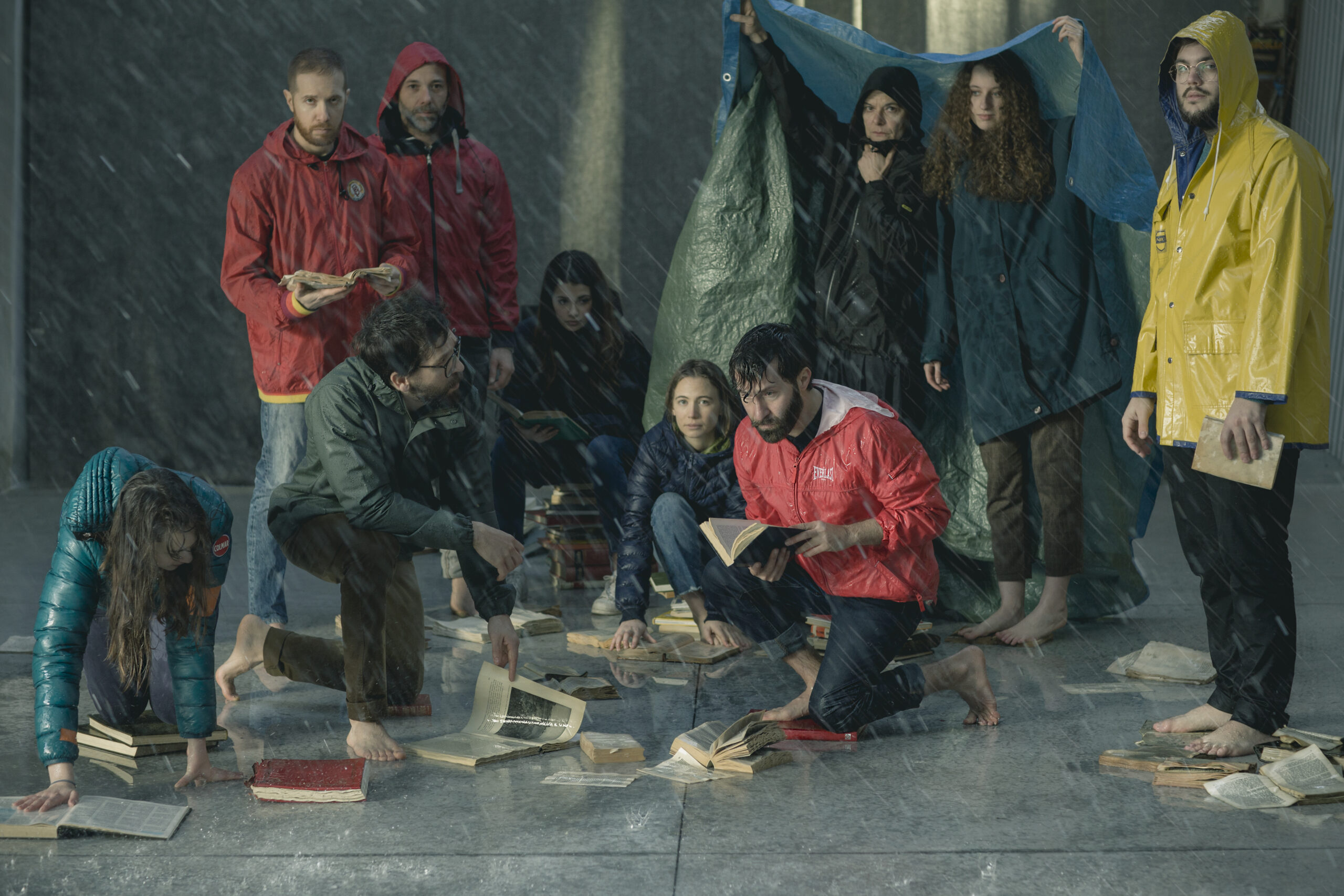
a presumptuous homage to the great soul of Andrea Zanzotto
texts by Andrea Zanzotto
with Leda Kreider and Marco Menegoni
music and sound design Mauro Martinuz
dramaturgy Simone Derai, Lisa Gasparotto
direction, sets, lighting Simone Derai
voice of the Venetian recitative Luca Altavilla
the scene hosts an evocation of the work Wood #12 A Z courtesy of Francesco De Grandi
realizations Luisa Fabris
promotional image created by Giacomo Carmagnola
Production Anagoor 2022
co-production Centrale Fies, Fondazione Teatro Donizetti Bergamo, ERT / Teatro Nazionale,
TPE- Teatro Piemonte Europa / Festival delle Colline Torinesi, Operaestate Festival Veneto
The title of this work alludes to the verse collection IX Eclogues that Andrea Zanzotto published in 1962. The poet from Pieve di Soligo chose out of modesty to stand one step behind the luminous Virgil and the ten eclogues of the Eclogues. Today, however, we can discern in Zanzotto’s entire oeuvre the realization of a poetic chain that from Virgil (to Dante, to Petrarch, to Hölderlin, to Leopardi, to Pasolini, to Celan… transiting and relaunching bridges from poet to poet) carries the flame beyond. Not a race among poets, but a relay race: thus tradition is subjected to the bitter end in order to put oneself at risk more than one’s fathers, to stand in a precarious balance between the aura of the past and the disenchantment to which poetry is heading in this post-capitalist society. Zanzotto seems to gather all the witnesses, all the signs of light coming from the past and, glimpsing forward the indecipherable signs of future light, he lifts and shakes the lantern in the night of the present making himself Virgil for all of us. Ultra modern and very ancient at the same time, Zanzotto knows well that literature is like a chorus of dead voices. The ultra-modernity from the very ancient that connotes Zanzotto is not, however, a purely literary datum, and the superimposition of the bucolic to one’s own landscape, one’s own language, is never flat literary memory, but rather̀ a perception of an irremediable rupture between those who are now “poured into the two thousand” and that lost world. This awareness coincides and extends into consciousness of the fault on which one walks, which is a paleontological rather than a cultural-historical vision: one can no longer speak of tradition neutrally, forgetting that the centuries between Homer and us are nothing compared to the vertigo of biological, geological and even more astrological time. Zanzotto captures and illuminates the hell into which we are lowered and yet stubbornly holds the fire of a childlike hope. His entire oeuvre reveals a complex and iridescent nature, elusive but not obscure: the poet of the landscape, through the vision of the devastation of the landscape and the crisis of the inner landscape, psyche and language, grasps and connects the causes and effects of a pain that renders dumb, soon rising as a civil and historical and even metaphysical force. It is here that the master’s achievement is manifested: the whole of Zanzotto’s work as a new eclogue, beyond Virgil’s ten, speaks the future voice of prophecy and renews the vision of a child who will come and smile at his parents. A subtitle accompanies the main title “a presumptuous homage to the great soul of Andrea Zanzotto” just as the IX Eclogues had been called by Zanzotto himself “a presumptuous homage to the great soul of Virgil”: we thus recognize as inevitable the flaw with respect to an immense work and (however love-driven) arrogant any attempt to define it.
ANAGOOR AND ZANZOTTO
Anagoor is based in Castelfranco Veneto and has an operating atelier in the Treviso countryside in a former rabbit farm converted into a theater.
It has always been concerned with the relationship between politics, language, the natural environment and the landscape: it does so by convening different languages on stage, a Babel of the arts (from visual arts to poetry) in an effort to tell the real and its fractures. The collective operates in Italy and abroad and has received several awards over time (including the Silver Lion for theatrical innovation at the 2018 Venice Biennale). Anagoor while never explicitly citing him has long embraced Zanzotto’s lesson. There are many similarities that tie the Castelfranco group to the poet from Pieve di Soligo: the radical choice to observe history from the periphery without this position implying closure and entrenchment, the complex relationship with tradition and the canon that determines a stubborn inactuality, the suffering from devastation, the tenacity in renewing the flame of arts only apparently unheard.
ANAGOOR, VERSE, ZANZOTTO AND PASOLINI
Ecloga XI continues the scenic investigation of the poetic word that Anagoor has always conducted. L’inutile ronda and Ciclogenesi (Operestate Veneto 2005 and 2006) were two first embryonic experiments on verses by Andrea Zanzotto, Amelia Rosselli, Alda Merini, Maria Luisa Spaziani, Silvia Bre, Patriza Valduga, Giulio Mozzi and others.
With Alda Merini’s Magnificat (2008) Anagoor begins a path of exclusive attention related to single poetic voices. With this work it starts the exploration of the mystery of the word and the suffering of the poet that becomes flesh through the voice of the actor.
The confrontation with the Latin verses of the 2nd book of theAeneid, among the most painful and violent produced by poetry of all times, leads to the creation of Virgil Burns (2014): at once a reflection on the fire of artistic creation, a look at history and a shamanic evocation of tradition. Marco Menegoni’s memorable performance recorded at the Piccolo Teatro in Milan is now decanted onto vinyl for imperishable memory. A desperately amorous concerto/masque(Master/Mistress, 2017) composed on the sonnets of William Shakespeare slips into the dark territories of passion and anticipates the dark times of the pandemic. The translation of Aeschylus’ verses for the staging of theOresteia are the subject of analysis in Una festa tra noi e i morti, publication by Cronopio Publishing House, 2020. But it is with Pier Paolo Pasolini’s L’italiano è ladro (2016) that Anagoor declares, like a manifesto, its position as a medium that renounces neither critical reflection nor total emotional adherence to the burning urgency of verse. Coming to Zanzotto after Aeschylus, Virgil and Pasolini is politically inevitable passage. Zanzotto points to the symptoms of an ongoing mega-disease. It is a crisis of “an idea of man that has remained fairly stable for millennia,” but it is a vision that surpasses even the Pasolinian anthropological mutation. If Pasolini ultimately prioritizes still a class dynamic, with the idea of cultural genocide in describing the end of the millennial peasant world, Zanzotto as in an extreme apocalyptic relay overcomes it on an ecological and planetary level. In describing his apocalypse, Pasolini remains in an anthropocentric perspective, not abandoning the dimension of human time. On the contrary, through the expression end of the aeon, and in the context of a very lucid vision of the ultimate climatic devastation Zanzotto inserts his reflection in a non-human time, that, unthinkable and perturbing, of geological eras.
ANAGOOR, THE IMAGE, ZANZOTTO AND GIORGIONE
Ecloga XI opens for viewers with an act of pure listening in the absence of an image. An acoustic reproduction of a magnetic tape is offered. The tape contains the recording of an event that is a double fake: it is an imaginary ancient Venetian carnival, a false document from an unspecified historical epoch, but it is also the reenactment, inauthentic, of the celebrated incipit of Fellini’s Casanova for which Zanzotto composed the verses of the Venetian Recitative later collected in Filò. The emersion and collapse of the idol, the great head of Reitia ancient goddess of the peoples of the upper Adriatic, weaver, stitcher, repairer, imago and venusia, desired and denied, given birth to by the imagination of Fellini-Zanzotto, tells of many things: of the protervia of an entire society (local and universal), but also of its fragility, of the eternal need to construct images by art, of their ineffectiveness, of the ability of the word to stitch together the missing pieces as in a dream. Although it might have seemed a congenial way to reiterate Zanzotto’s ecological denunciation, in Ecloga XI Anagoor completely renounces the use of video images with which he has repeatedly woven his own works, opening glimpses of the devastation of the earth and the violence perpetrated on other species. Instead, the curtain opens once again – like a stubborn note – on Giorgione’s Tempest to which Anagoor has dedicated other works in the past. A large reproduction of the Castelfranco painter’s canvas, the first and fulminating “landscape” in the history of art, stands without the three human figures: without the man with the pole and without the naked woman with the child, only the horizon of the turreted and deserted city immersed in and overlooked by nature remains. Pure landscape, yet not pure nature. The horizon and vision of nature are hopelessly mediated, filtered, infected, corrupted by culture. Etiquette and the forest. Antinomy par excellence: the gap and the drifts generated by this tension have psychic, ethical, political implications. And when the earthquake opens the fault, the psyche landslides and the language splits. Some poets as seismographers know how to make themselves antennae.
But when did it happen?
To say the origin is impossible except by endless catabasis: one could only descend into the realms of the dead, into violent hells. Is it the death of the father as with Aeneas or the collapse of that great oak tree after a stormy night? Is it the burning of the village of Pieve by the Nazis? Is it the long agony of one’s comrade who fled into the open field unprotected by cobs and caught up in machine gunfire? Are they the victims of Hiroshima? The millions of deaths of all the Montellians in history? To prepare for the concrete devastation of warehouses, asphalt arteries and excavations there are countless other graves and other pits. One would only have to found the vomit party.
Zanzotto’s father was a painter. In the house he painted a frieze that was an artificial mirror of the external horizon observable from the windows, blue mountains, forests, vegetable gardens, broli, a backdrop of paradise, an Edenic theater of animals and vegetables at the center of which the painter father placed Andrea himself, his child son dressed as a prince.
The horizon of the landscape surrounds Zanzotto in a ring, outer and inner, natural-artificial, a most sweet and mummifying embrace, but also a silkworm that prefigures a metamorphosis.
Beyond the landscape, graphically crossed out as he chose to write it at some point, the head of Reitia, weaver and stitcher, desired and denied, returns to tell endless possibilities of repair and mending. It is from the darkest dense of the forest, from the most inextricable tangle of the thicket, that the thread of possibilities to come germinates.
Behind the denied landscape, obscured like the icon beneath Malevič’s black painting, a new idol rises, hoisted up like a torn and stitched backdrop of paper, another painting, a new artifice. The work evoked by direct concession and collaboration of its author is Wood #12 AZ by Francesco De Grandi, a Sicilian painter whose phosphorescent, radioactive forest crowns the prophecy of a future horizon.
Anagoor, in just a few years at the center of Italian and European theatrical attention, is the Silver Lion for Theater 2018. The company has conducted profound work on the search for a new language by drawing on images and symbols that lead back to our cultural memory. “Anagoor’s work, never lacking a powerful aesthetic, manages to have a popularizing function with respect to major themes; Anagoor is never popular in its choice of texts, yet it is, nobly, so in its artistic restitution. What makes their work at times conceptual but also profoundly artisanal is the fact that they do not delegate the artistic choice to anyone, succeeding as a collective to realize everything by themselves, from the writing of the text to the construction of scenes and costumes that are always of great impact, to such an extent that their shows are programmed in many Italian and foreign theaters” (from the motivation). The Anagoor company is founded by Simone Derai and Paola Dallan in Castelfranco Veneto in 2000, immediately configuring itself as an experiment in collectivity. Today the direction of Simone Derai and Marco Menegoni is flanked by the constant presences of Patrizia Vercesi, Mauro Martinuz and Giulio Favotto, while artists and professionals continue to join in, enriching its path and emphasizing its nature as a collective. A continuous workshop, open to professionals and neophytes, Anagoor is the bed of a creation open to the city and its different generations, where, in a strenuous attempt to generate a theatrical art of the polis, the pedagogical action in schools, the intervention in the territory, the call to the community, and the company’s productions find no solution of continuity. Anagoor’s theater responds to an iconic aesthetic that precipitates in different final formats where performing art, philosophy, literature and hypermedia scene enter into dialogue, claiming nevertheless, forcefully and by virtue of the nature of this art, to remain theater. Among the performances: *jeug- (2008); Tempesta (2009), special mention at the Premio Scenario; Fortuny (2011); L.I. Lingua Imperii (2012), among the winning shows of Music Theatre NOW 2015; Virgil Burns (2014); Socrates the Survivor / Like Leaves (2016) nominee for the UBU Awards as show of the year, Orestea / Agamemnon Slaves Conversio (2018) selected in the New Settings program of Fondation d’entreprise Hermès. In 2012, the company approached musical theater with the film-concert Et manchi pietà, which was followed by three opera productions: in 2013 Il Palazzo di Atlante by Luigi Rossi (1642), presented at the Sagra Musicale Malatestiana in Rimini; in 2017 Faust by Charles Gounod, a production of Teatro Comunale di Modena, Teatro Valli di Reggio Emilia and Teatro Municipale di Piacenza; and in 2019 Das Paradies un di Peri by Robert Schumann, a production of Teatro Massimo di Palermo. Among the awards they have received: the “Jurislav Korenić” award to Simone Derai as best young director at the 53rd MESS Festival (2012), the Hystrio – Castel dei Mondi Award (2013), the ANCT Award for innovative theatrical research, the HYSTRIO award for directing (2016) and the ReteCritica Award. Since 2008 Anagoor has been based in the Treviso countryside, at La Conigliera, a burrow farm converted into an atelier, and since 2010 has been part of the Fies Factory project of Centrale Fies – art work space.
Distribution and information
Michele Mele
Tel. 347.2934834
E-mail: michelemele@anagoor.com
anagoor.com
Photo Credits – Luciano Rossetti
ACCABADORA
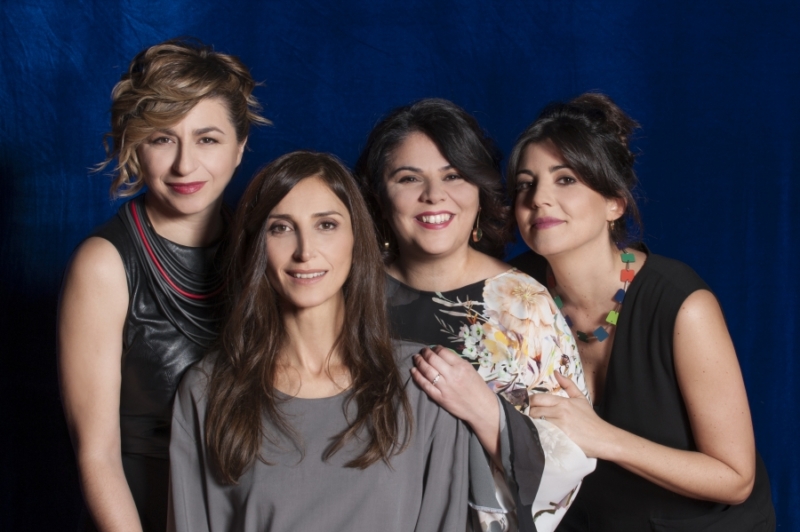
from the novel by Michela Murgia
published by Giulio Einaudi Editore
dramaturgy Carlotta Corradi
direction Veronica Cruciani
scenes and costumes Barbara Bessi
lighting Gianni Staropoli
video Lorenzo Letizia
assistant director Giacomo Bisordi
with Monica Piseddu
production Compagnia Veronica Cruciani,
Teatro Donizetti Bergamo and Cranpi Spettacoli
Accabadora, one of Michela Murgia‘s most beautiful novels and one of the most widely read books in Italy in recent years (Einaudi 2009; winner of the 2010 Campiello Prize), is Veronica Cruciani‘s new show.
It was written by Carlotta Corradi at the request of the director, who immediately thought of making it a monologue starting from the point of view of Maria, the daughter of Bonaria Urrai the accabadora of Soreni. Their proposal was immediately accepted by the Sardinian writer, who for the first time decided to support and accompany the birth of a show born from her novel. Michela Murgia tells a story set in a fictional village in Sardinia, where Maria, at the age of six, is given to fill’e anima to Bonaria Urrai, a seamstress who lives alone and who on occasion acts as accabadora. The word, from the Sardinian tradition, takes its root from the Spanish acabar meaning to finish, to kill; Bonaria Urrai helps dying people to die. Maria grows in admiration of this new mother, more cultured and caring than her predecessor, until the day she discovers her true nature. It is then that she flees to the continent to change her life and forget the past, but a few years later she returns to Tzia’s deathbed. It is at this point in the story that the play begins. Maria is now a woman, or would like to be. But her stay on Tzia’s deathbed challenges all her certainties.
“I chose this novel because this story proposes to us an alternative model of family, where the mother is not the biological one but the adoptive one, and therefore a different model of society; it has a political aspect, which is what always interests me in the stories I choose to stage.
The dialogue between Maria and Tzia Bonaria, her mother, for me takes place only in the head of the protagonist; it is a dialogue between herself and a part of herself, between a daughter and her inner parent. That is why on stage I placed a gray wall representing a mental space, Maria’s skull box from which also come sounds, sounds of night darkness in which sleepless Maria tries to overcome the grief of the death of this de facto mother. From a psychoanalytic point of view the first great mourning is precisely ‘I am not my mother.’ The imitative period ends and the phase of bodily self-awareness begins. It is through a process where we bring out a series of diversifications that the process of separation takes place, and this inevitably causes a form of distress. The killing of her aunt thus becomes a metaphor for Mary’s growth from immature to womanhood, traversing the painful past and projecting into the future.
There is an ancient folk belief that ascribes to the appearance of the Double the meaning of impending death. The figure of death takes on bodily semblances, specific and unmistakable, of the individual who experiences it. The message can be translated thus I am the thing most familiar to you and at the same time the most terrifying thing you yourself may encounter, I am that which you have always known and always ignored.”
Veronica Cruciani
“The monologue, after all, tells a love story. In this case, between a daughter and a mother. In this case, not the birth mother. But the other mother. The two major themes that we would call today euthanasia and de facto motherhood, in the play as in the novel, create a scope for reflection but are never as central as love and growth. Growth always and inevitably linked to the relationship with one’s mother, whether natural, adopted or acquired.”
Carlotta Corradi
“Carlotta Corradi did a weaving job, using all my words, but in a way that I did not use them. There is also authorial originality in this text. To call it a ‘reduction’ is not good: it is an expansion. A view that I did not take because my focus was on the old woman, not the child. It is a piece of Mary that was missing; I am happy that other women saw it. Probably ten years ago, when I wrote the novel, I was not able to see the adult Mary. Now it is a pleasure to read her in the words, in the eyes, in the artistic gesture of other professional women. Although I did not write a word, I could counter-sign it, I feel it very much my own, very much like the literary intention that was in the novel.”
Michela Murgia
Veronica Cruciani is an actress and director. In 2003 Ascanio Celestini wrote for her the monologue Le Nozze di Antigone – reported at the Riccione Prize and winner of the Oddone Cappellino Prize – of which she is performer and director together with Arturo Cirillo. In 2004 she founded the Compagnia Veronica Cruciani with which she investigates the relationship between memory and contemporary dramaturgy. In 2009 he won the Cavalierato Giovanile – Best Talents under 35 award and in 2012 the Hystrio-Anct Award of the Association of Italian Critics. Among his latest productions: Il ritorno by S. Pierattini, of which she is director and producer (2007), winner of the Anct critics’ prize as best Italian text, La palestra by G. Scianna (2011), Peli by Carlotta Corradi (2013), Preamleto by Michele Santeramo produced by Teatro di Roma and Due donne che ballano, produced by Teatro Carcano in Milan (2015), La bottega del caffè by R.M. Fassbinder, produced by Stabile del Friuli Venezia Giulia (2016), Quasi Grazia by Marcello Fois with Michela Murgia in the role of Grazia Deledda, produced by Sardegna Teatro. Since 2013 she has been artistic director of Teatro Quarticciolo in Rome.
Monica Piseddu graduated as an actress from the Silvio D’Amico National Academy of Dramatic Art. Since 2002, she has worked for over ten years with Arturo Cirillo in numerous productions, including L’Ereditiera, Le Intellettuali, Le cinque rose di Jennifer, Otello, and Lo zoo di vetro. She has also worked with Mario Martone in Oedipus at Colonus, with Daria Deflorian and Antonio Tagliarini as actress and project collaboration in Ce ne andiamo per non darvi altre preoccupazioni, with Massimiliano Civica in La Parigina and L’Alcesti, with Antonio Latella in Natale in casa Cupiello and Ti regalo la mia morte, Veronika. In cinema he worked with Paolo Sorrentino in La grande bellezza, and with Marco Bellocchio in Fai bei sogni. In 2007 she received the Ubu Award best supporting actress, in 2015 the Premio della Critica, the Ubu Award best actress and the Le Maschere Award best supporting actress, and in 2016 the Hystrio Award for interpretation.
Carlotta Corradi, born in 1980, playwright, won the 2014 Mario Fratti Award for dramaturgy as part of the InScenaNy Festival with the text Via dei Capocci, translated into English and staged at the Theatre For A New City in Manhattan; the text is published in Italian by Editoria&Spettacolo in the volume New Writing Italia 2. In 2012 he wrote Peli – published by Editoria & Spettacolo in the volume “Trittico a nudo” – which was produced by Fondazione RomaEuropa and AtclLazio under the direction of Veronica Cruciani. In the same year he joined the dramaturgy group led by Fausto Paravidino at Teatro Valle Occupato. As part of this he wrote Arithymia, a finalist for the 2014 Hystrio Scritture di scena award. In 2017 he is a finalist at the Riccione Prize with the text Nel bosco. In addition to writing for the theater, he is a documentary filmmaker.
Budapest – Hungary
“Within minutes, the audience adapts to this strange language and is transported into a kind of fluttering, familiar nostalgia, as if in a distant dream.”
“Time becomes a relative concept in this garden. There is no linear narrative, only sequences of images that allow us to savor the feeling of swimming in the endless ocean of grief and remembrance.”
Fidelio.hu – 03/23/2017
Distribution and Information
Gerosa Michela
Tel. 035.4160612
E-mail gerosa@
Photo Credits – Marina Alessi
IVAN
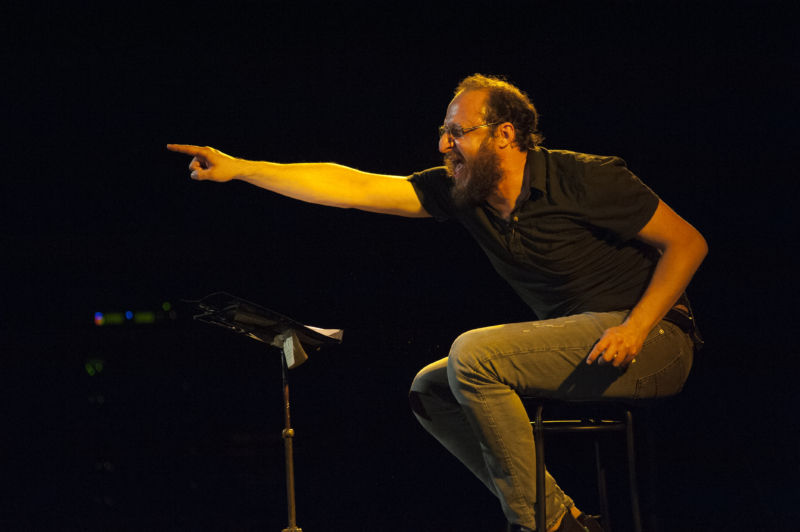
freely adapted from The Brothers Karamazov
by Fedor Dostoevsky
rewriting Letizia Russo
consulting Fausto Malcovati
direction Serena Sinigaglia
scenes Stefano Zullo
lights Roberta Faiolo
assistant director Giulia Sarah Gibbon
with Fausto Russo Alesi
production ATIR Teatro Ringhiera and
Teatro Donizetti Bergamo
The novel has a precise scansion: twelve books divided into two parts, each of six books. It begins with the prehistory of the Karamazovs: their father Fyodor, a vulgar histrion who indulges in lust with animalistic complacency; their three children growing up loveless, without mothers (Mitya is the son of his first wife, Ivan and Alyosha of his second, both of whom died early), in random families, lacking reference points.
In the second book their meeting in Father Zosima’s cell: dormant conflicts erupt, the savage violence of the Karamazovs surfaces, the atmosphere of murder is already in the air. This is followed by several books that have a clear slowing down effect: the actual action takes a back seat, it is as if suspended, everything takes place on the level of verbal action, the ideological theme, confession, self-analysis dominate.
Beginning in the third book is the first son, Mitya: capable of magnanimity and baseness, he is the Karamazov who will pay most dearly for the moral chaos in which everyone moves. In the third book, the fourth son, the bastard Smerdjakov, also enters the scene: deformed, afflicted with epilepsy, silent, filled with resentment at the role of servant to which his father forces him, plagued by Ivan’s brilliant and corrosive intelligence, with no ties to his land and people (he claims to hate Russia, dreams of France), he will be the material perpetrator of the crime.
In the fifth and sixth books two other major verbal messages: the confession of Ivan followed by the “Legend of the Grand Inquisitor” and the life of Zosima, which Alyosha recounts from the lips of the dying starec. […]. In the last six books it is the murder of the father that sets the pace. The action is tumultuous: one after another, the characters undergo crises, metamorphoses, and journey toward one of two abysses: upward, salvation, or downward, annihilation.
The seventh book opens with “The Wedding at Cana”: the realization of the utopia of love, the moment of panic joy, the transformation of Alyosha from a teenager to a man ready for battle.Book eight is Mokroe’s wild orgy: overwhelmed by wine and dancing, Mitya and Grušen’ka experience their great last hour of free and total love. Then, the arrest, the collapse of all illusions.
In the ninth book the trap is tightened around Mitya: the overwhelming evidence points him out to everyone as a parricide. For him there is no escape. But out of the desperate situation comes a new faith, a new consciousness. The tenth book is devoted to the theme of children, one of the central themes of the novel that will have its apotheosis in the epilogue: to them Alyosha entrusts the message of peace and mutual understanding.
Theeleventh book marks Ivan’s crisis and collapse: the three encounters with Smerdyakov confront him with his precise co-responsibility for patricide, the perverse will of his insatiable dialectic. Tension and anguish ravage his corrupting soul and produce the devil’s hallucination: the brilliant ideological and moral castle of the skeptical intellectual finally collapses; cowardice, moral misery, mental illness remain. The last book is the trial. […]
Fausto Malcovati, Introduction to The Brothers Karamazov, Garzanti
Dear viewers,
let me introduce you to this show by briefly telling you about us.
First, the actor: Fausto Russo Alesi.
Of him I certainly do not want to recall the merits and talents, which, to most, are already known. No, here I would like to emphasize the deep friendship and the long-standing artistic association between us.
It is rare for us thespians to find ourselves over time and though changed, rediscover the love and passion we have always had.
We, who started together in our early twenties.
It was the year 1992, the First Republic collapsed under the blows of Tangentopoli, and we, kids, discovered ourselves friends and colleagues, lovers of a theater we did not know but would mark the lives of both of us. The same theater, the same spasmodic search for meaning to live for, for a mark to pass on. Yesterday, with the many shows we experienced together, today in this new, wonderfully difficult adventure.
And here I am urged to tell you about myself. A few, very few lines.
I love the classics. I love the great Russian literature of the 1800s because in it men still dared to ask the why of things, dared to deal with the great themes of existence, a rather unusual exercise of wit for our noisy times.
Who are you? What is man? What is the meaning of his acting in the world? What is freedom? Is there order in chaos? And does violence, the violence with which man is steeped, have any possible atonement?
To indulge in reading The Brothers Karamazov is a journey through time through men, into man. And here stands out a man among men, or perhaps he is just a boy too mature for his years, the second of the Karamazov sons, the most tormented, the most absolutely human: Ivan.
Man and all of humanity as seen through the eyes of Ivan Karamazov, this our journey. The Brothers Karamazov according to Ivan, if you will.
But how to do it yourself?
I love the classics and I love Dostoevsky, I have already said that. Fausto is perfect for Ivan, that too…no, I haven’t said that yet, but believe me on trust, if on your own you haven’t already thought so. But the two of us are not enough in the face of the enormity of the journey undertaken. I therefore introduce the other two fellow adventurers.
Letizia Russo, a playwright, an original, unique intellectual, capable of looking at the world and transcribing it as if it were her own all along. It is up to her to construct a dramaturgy that from the book can encapsulate Ivan’s thoughts and actions. Not only “The Grand Inquisitor” then but the nerves, the muscles, the soul, the blood of the man who gave birth to that tale. He, Ivan.
And finally Fausto Malcovati. Professor Fausto Malcovati. A boast for us Italians, if only we were able to boast of something other than a footballer. One of the greatest connoisseurs of Russian language and literature in Italy. Fausto will help us to distinguish, to know, to translate, to betray without “violating” the work of the immense Russian author.
Nothing more I can add here, to speak from now is the show.
And that you want to appreciate and enjoy it is the sincere wish of all of us.
To the theater, then! To the theater!
Serena Sinigaglia
Serena Sinigaglia (1973) graduated from the theater directing course at the Civica Scuola d’Arte Drammatica Paolo Grassi. Since 1996 she has been the founder and artistic director of ATIR. He has also been artistic director of Milan’s Teatro Ringhiera since 2007. Her directorial path has always been articulated through different strands. That of the classics, among which are shows such as: “Romeo and Juliet” and “Lear ovvero tutto su mio padre” by W.Shakespeare, “Trojan Women” from Euripides, “Women in Parliament” from Aristophanes, in co-production with the Piccolo Teatro di Milano, “Nozze di Sangue” by Federico García Lorca, translated into Barbaricino by Marcello Fois. In addition, Serena Sinigaglia has always dedicated herself passionately to contemporary dramaturgy. The main steps along this path have been the shows “1943 – Come un cammello in una gondaia” based on the Letters of the condemned to death of the European Resistance; the UBU prize-winning show “Natura morta in un fosso” by Fausto Paravidino with Fausto Russo Alesi; “L’età dell’oro” by and with Laura Curino; “Il grigio” by Gaber/Luporini, a Piccolo Teatro di Milano production, with Fausto Russo Alesi; and the two concluding chapters of the project Incontro con epoche straordinarie: “1968” and “1989 – collapses”; “The Bug” by Majakovsky, production Piccolo Teatro di Milano (2009); “Beauty and Hell” by and with Roberto Saviano for Piccolo Teatro di Milano; “Naples is not measured by the mind” by Mario Santanelli production Napoli Teatro Festival 2009 and RAI Radio Televisione Italiana in collaboration with ATIR; “Perspectives for a Civil War” by Enzensberger; “Settimo” by Serena Sinigaglia at the Piccolo Teatro in Milan (2012); “Ribellioni Possibili” by Luis García-Araus and Javier García Yague, an ATIR production nominated for the 2013 UBUs; and in 2014 the unreleased text “Italia Anni Dieci” by Edoardo Erba, an ATIR production, and the text “Alla mia età mi nascondo ancora per fumare” by French-Algerian playwright Rayhana, an ATIR production.
In 2015 he signed the direction of the first theatrical serial in Italy, “6Bianca” by Stephen Amidon, a Fondazione del Teatro Stabile di Torino production in collaboration with Scuola Holden, and (also in 2015) that of “Utoya” by Edoardo Erba with Arianna Scommegna and Mattia Fabris, a Teatro Metastasio production; in 2016 he directed Alan Bennett’s “Nudi e crudi,” with Maria Amelia Monti and Paolo Calabresi for Artisti Associati, and Jon Robin Baitz’s “Tre alberghi” with Maria Grazia Plos and Francesco Migliaccio, a production of Teatro Stabile del Friuli Venezia Giulia.
Since 2001 Sinigaglia has also measured himself with opera in several productions, most recently “Carmen” at the Sferisferio as part of the Macerata Opera Festival. In 2014 he made his debut with “Tosca” at the Teatro La Fenice in Venice. In May 2008 he published his first novel “E tutto fu diverso” for the publishing house Rizzoli.
Awards include: Donnediscena National Women’s Directing Award (2005); Franco Enriquez Award (2006); Hystrio Award to the ATIR company for the quality and commitment of the company demonstrated over the years (2006), Milanodonna Award 2007 from the City of Milan; Gold Medal 2007 awarded by the Province of Milan for the activity promoted by ATIR; Regium Giulii Award 2008 for the best first work with the novel “E tutto fu diverso”; Milan Prize for Theatre 2009 for the best show with “L’Aggancio”; Hystrio-Provincia di Milano Prize at Teatro Ringhiera/ATIR 2012; the nomination to the UBU Prizes 2013 with the show “Ribellioni Possibili,” Critic’s Prize 2014 and Hystrio Prize for Direction 2015.
Fausto Russo Alesi, a graduate of the Civica Scuola d’Arte Drammatica “Paolo Grassi,” has been a member of A.T.I.R. since 1996.
In 2002 he was awarded the prize of the National Association of Theater Critics. In the 2000/2001 season he is Kostja in Chekhov’s The Seagull, directed by Eimuntas Nekrosius; for this performance and that of Natura morta in un fosso by Fausto Paravidino, directed by Serena Sinigaglia, he receives the 2002 UBU Award as best young actor. In January 2003 he is the winner of the 21st International Fadjr Theatre Festival in Tehran (Iran), awarded by the I.T.I. Unesco. In 2004 he performed Giorgio Gaber’s Il Grigio, directed by Serena Sinigaglia, receiving the “Premio Olimpici del Teatro” (ETI 2004 award), the Annibale Ruccello award (2004), the Vittorio Gassman award, the Maschera d’oro and the Persephone d’oro (2005). He is the performer and director of Letizia Russo’s play Edeyen. He has also worked with Gigi Dall’Aglio, Ferdinando Bruni, Armando Punzo and Gabriele Vacis, with Peter Stein (Dostoevsky’s The Demons) and again with Serena Sinigaglia (Nadine Gordimer’s The Hook).
Directed by Luca Ronconi he has starred in Il silenzio dei comunisti, Fahrenheit 451, Nel bosco degli spiriti, Sogno di una notte di mezza estate, The Merchant of Venice (as Shylock), Rafael Spregelburd’s Modesty, Brecht’s St. Joan of the Slaughterhouses (UBU Best Supporting Actor Award). For the role of Kirillov in The Demons and Bottom in A Midsummer Night’s Dream, he won the 2009 UBU Award for best supporting actor. Still at Piccolo he was sole performer and director of Lars Norén’s 20 November and, in the 2010/2011 season, he starred in Lessing’s Nathan the Wise, directed by Carmelo Rifici.
Other recent performances include starring in and directing Antonio Calabrò’s Cuore di cactus.
For cinema he was directed by Silvio Soldini in Bread and Tulips and in Agata and the Storm; he starred, among others, in Mario Monicelli’s Le rose del deserto, Saverio Costanzo’s In memory of me (in competition at the Berlin Film Festival), Marco Bellocchio’s Vincere , in competition at the 2009 Cannes Film Festival, Giuseppe Capotondi’s La doppia ora , in competition at the 2009 Venice Film Festival, and Carlo Mazzacurati’s La passione , in competition at the 2010 Venice Film Festival. In 2012 he appears in three films, Romanzo di una strage, directed by Marco Tullio Giordana; Venuto al mondo, directed by Sergio Castellitto; and Il comandante e la cicogna, directed by Silvio Soldini.
For Radio Rai he read Turgenev’s novel Fathers and Sons .
Letizia Russo, born in Rome in 1980, began writing for the theater at the age of 17, upon winning the Grinzane-Cavour prize with Dialogue between Punchinello and Christ. Her first text, Niente e Nessuno, was staged in 2000 at the Festival Per Antiche Vie, directed by Mario Martone, and directed by Marcello Cotugno, with Ciro Damiani, Giancarlo Ratti and Alessia Giuliani.
In 2001, with Tomba di cani, it won the Premio Tondelli (Riccione Prize); the text was staged in 2002 by ATP in Pistoia, directed by Cristina Pezzoli, with Isa Danieli, Peppino Mazzotta, Sara Bertelà, Federico Pacifici, Giuliano Amatucci, Aram Kian, and Enrico Casagrande. The text won, in 2003, the UBU Prize as best new play. The text has been translated and performed in Germany, France, Chile, Brazil, Portugal, and Slovakia. In 2003, on commission from the National Theatre in London, he wrote Binario Morto – Dead End, for the Shell-Connections festival, and it was performed, in translation by Luca Scarlini and Aleks Sierz, by thirty-two youth companies throughout the UK and performed at the National Theatre in London in 2004. In 2004 he wrote Babel, staged at the Petrolio festival, directed by Paolo Zuccari, with Paolo Zuccari and Roberta Rovelli. The text is translated and performed in France, Germany, Brazil, and Portugal. RAI made a television product of it directed by Sandro Vanadia in 2010. Also directed and performed by Paolo Zuccari, he wrote Primo Amore in 2005, a text that was a great success in Italy and abroad. The staging in Brazil, directed by Alvise Camozzi, with a translation by Rachel Brumana, earned João Miguel the Shell award for best interpretation. In 2015, the text was produced by Theatre Ouvert in Paris, with Mathieu Mantainer, directed by Isabelle Mouchard. For Fausto Russo Alesi, who directs and plays the lead role, he writes Edeyen, which debuts at the Taormina Festival in 2005, com Pia Lanciotti, Debora Zuin, Sergio Leone, Maria Pilar Perez Aspa.
ATIR (Associazione Teatrale Indipendente per la Ricerca) is a cultural association established in 1996 with its registered office in Milan on the initiative of young recent graduates of the Civica Scuola di Teatro Paolo Grassi; it is currently composed of nine founding members including actors, director, set designer, and has been continuously producing and touring for years, becoming over the years one of the most recognized and appreciated Italian companies. On May 17, 2016 it will turn 20 years old, a historic milestone that few artistic complexes can boast.
It also regularly conducts training activities through workshops for professionals and workshops open to the public, and for several years has consolidated a wide-ranging and articulated social activity aimed at disadvantaged audiences (the disabled, the elderly, the young).
In 2008, ATIR chose to stabilize and find a home, and took over, under an agreement with the City of Milan, a 230-seat public space located in the southern suburbs of the city, the Ringhiera Theater, a choice that has greatly increased the amount of activity organized and carried out, not least the programming of a theater season.
Since 2011, the Association has expanded to include new types of members: honorary and supporters, that is, public, friends and sympathizers who, through the instrument of assemblies, bring new energy for the future with their planning and economic contributions. Artistic direction is currently entrusted to Serena Sinigaglia (43) and organizational direction to Anna Chiara Altieri (39).
The Compagnia, which over the years of its existence has woven intense relationships at all institutional levels, has received and constantly receives contributions for its activities, in addition to the Ministry, from: City of Milan (which in 2012 also awarded ATIR the Certificate of Civic Merit, the Ambrogino), Lombardy Region. In the three-year period 2009/2011 ATIR received funding in the context of the call to support theatrical residencies (Être) by Fondazione Cariplo, and for the three-year period 2012/2015 a further contribution for management improvement with the project ATIR +20, for the growth and development of the Company’s structure. In 2015 the company gained access to a new three-year grant from Fondazione Cariplo under the “Sustainable Culture” call, again aimed at improving management and expanding audiences.
2013 saw the deepening of some important collaborations already initiated in previous years: IMAB (Ministry of Culture of Spain), Cervantes Institute, Consulate of Spain, Être Association of Lombard Theatre Residencies (of which ATIR is a member), as well as many local collaborations with universities and schools. Since 2013, ATIR has also begun to participate in the meetings of the European IETM network and has initiated an important local and national network project on theaters working in suburbs and areas of particular social problems (TTT project).
Distribution and information
Anna de Martini
Tel. 02.87390039 | 339.1154163
E-mail: annademartini@atirteatroringhiera.it | compagnia@atirteatroringhiera.it
atirteatroringhiera.it
Photo Credits – Marina Alessi
DEL CORAGGIO SILENZIOSO
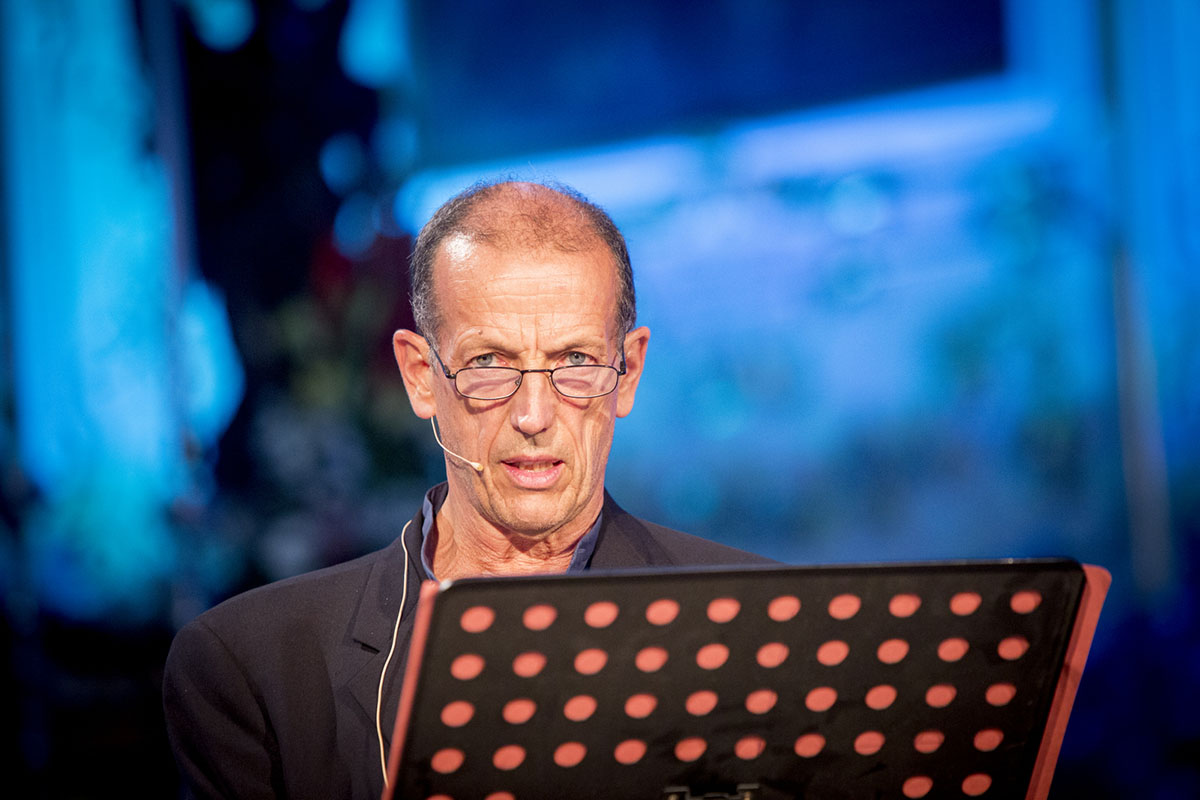
by and with Marco Baliani
collaboration on dramaturgy Ilenia Carrone
with music performed live
production City of Bergamo – Donizetti Theater – Alfieri House
Del Coraggio Silenzioso (Of Silent Courage ) made its debut on August 26, 2016 in Bergamo’s St. Alexander’s Cathedral, with music composed by Mauro Montalbetti and performed live by the Hegel Trio. Since then the reading has been presented on several occasions and is always changing, making use of new sound souls and always different settings. Among the musicians who have accompanied this reading: Mirko Lodedo, Fabio D’Onofrio, Max De Aloe.
Usually one associates with the word “courage,” a striking action, dictated by a pressing urgency, an action that defies death and takes possession of it, showing a luminous presence of the human.
It is the “numinous,” visible, displayed courage that happens under extreme conditions, and then becomes epos, tale, example.
But there is another kind of courage, silent and inconspicuous, and it is of this declination of the word Courage that this show wants to tell. Silent courage acts in the human being almost unexpectedly, does not presuppose a warrior temperament, does not stand out on the stage to show itself in the light, does not expect reward, not even that, posthumously, of the exhilarating tale. This courage acts in a submissive form, it also acts out of an inescapable urgency, but it does not demand gratitude, it does not wait for thanks, he or she who enacts it does so out of necessity, a necessity that has to do with the depth of the human within us, to which it is even difficult to give an explanation. Words such as compassion, solidarity, altruism, love, charity, goodness, try to circumscribe the human mystery of that act but more than anything else they only delimit its empathic value, because there are no words to explain how that impulse to act, in spite of everything, takes place in individuals who suddenly “feel” that they have to perform an act that is suddenly “necessary” for them. Antigone who, despite the prohibition of Creon’s law, goes to bury her brother’s body, paying for this transgression with death, is the archetypal example of this form of courage. “There are unwritten, inviolable laws that have always existed, and no one knows where they draw splendor.” It is this splendor of which Antigone speaks that I am going to look for in this play, that luminous kernel that transforms an entire existence into an exemplary yet silent act, luminous yet lived in the shadows, in modesty, in the sheer necessity of having to act. I will go in search of five narratives, five extreme situations, where to illuminate five existences, which, thanks to storytelling, become, in that ephemeral and powerful place that is the theatrical stage, five testimonies of taciturn courage. A simple dramaturgical structure, words and music intertwining to restore the outrageous simplicity of those human acts of silent courage.
Marco Baliani
Distribution and information
Ilenia Carrone
Tel. 338.3237507
E-mail: ilenia.carrone@gmail.com | segreteria.baliani@gmail.com
marcobaliani.it
Photo Credits – Gianfranco Rota
FOR YOU dedicated to you, dear Julie
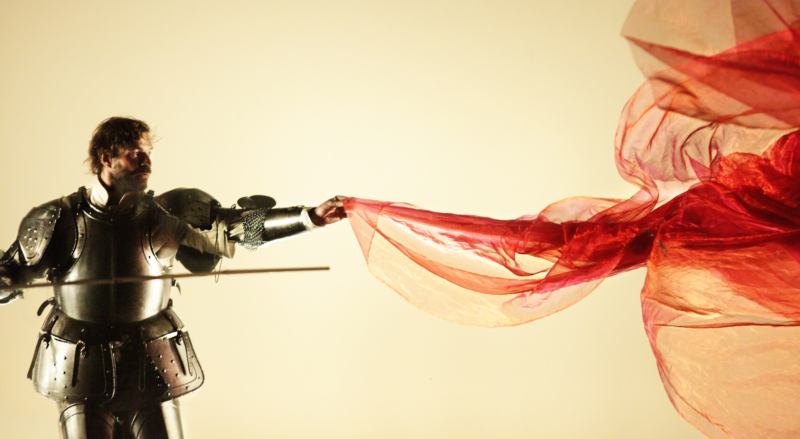
written and directed by Daniele Finzi Pasca
music, co-design sound and choreography Maria Bonzanigo
set design and accessories Hugo Gargiulo
costumes Giovanna Buzzi
co-design lighting and production director Alexis Bowles
video designer Roberto Vitalini
air sculpture designer Daniel Wurtzel
production consultant Antonio Vergamini
co-design and sound technician in creation Fabio Lecce
assistant director & stage manager Allegra Spernanzoni
assistant director & tour artistic director Geneviève Dupéré
make-up designer and hairstyle designer Chiqui Barbé
on stage Allegra Spernanzoni, Andrée-Anne Gingras-Roy, Beatriz Sayad, David Menes, Erika Bettin, Evelyne Laforest, Félix Salas, Francesco Lanciotti, Jens Leclerc, Marco Paoletti, Moira Albertalli, Nicolò Baggio, Rolando Tarquini and Stéphane Gentilini
production by Compagnia Finzi Pasca
in co-production with LAC – Lugano Arte e Cultura,
RSI – Radiotelevisione Svizzera,
OSI – Orchestra della Svizzera Italiana and Teatro Donizetti
partenaires at the creation Cornercard, Fidinam, Grand Hotel Villa Castagnola,
Caffè Chicco d’Oro and international partner Helsinn, Clay Packi
with the support of City of Lugano, Canton Ticino and Pro Helvetia.
Duration: 1 hour and 40 minutes (with intermission)
“Gutted stage, technicians and actors moving like cats in the dark, getting ready, slowly immersing themselves in the story. And the story will slowly envelop the viewer, the story of a book given away, of a garden to be built, of a struggle like the struggles we all must experience and face sooner or later.
Julie believed that everyone should try to build an inner garden where they go for refuge, where they welcome those they love, those they have lost and those they would like to discover.
So we will tell the story of a bench and a garden, then there will be the fragility that each of us defends with armor and armor. There will be the lightness of remembering his laughter, his little books full of calculations and notes, his advice and dreams. It is the mission of every life to try to build an inner garden where one can go for refuge, where one can welcome those one loves, those one has lost, those one would like to meet in an intimate and private place. We have so much told stories confined in enclosed spaces, imagined in the secret box we carry attached to our backs, inside which we generate dreams and imaginary journeys.
This show is dedicated to those who plant seeds that become trees, those who draw imagined open spaces to reflect, to soothe the soul.”
Daniele Finzi Pasca
June 21, 1972 – May 14, 2016
Montréal – Lugano
A girl in a man’s world. Julie has had an exceptional path. Young, at 21, she is co-founder of Cirque Eloize in Montréal. The shows she produces take the company to the world’s most renowned stages, moreover, thanks to her international development work for which she is responsible.
A magical encounter occurs when Julie meets Daniele after a performance of Visitatio, a show by Theatre Sunil and Carbone 14 at the Usine C in Montréal in 2000. Julie invites him to collaborate. This collaboration will give birth to the Sky Trilogy, composed of Nomad, Rain and Fog. These three shows will tour the world proposing a unique signature and a particular style of creative approach: “the theater of the caress.” Julie will fully identify with this technique developed by Daniele and Maria Bonzanigo. The time having come to continue her journey with Daniele, her great accomplice in life and the arts, they founded Inlevitas together in 2010. A year later, Inlevitas will join with Teatro Sunil to give birth to Compagnia Finzi Pasca with the same companions of the first collaborations, namely Antonio, Hugo and Maria who already had more than fifteen creations in their path. After the Trilogy of Heaven and Corteo for Cirque du Soleil, there was the Closing Ceremony of the Winter Olympic Games in Turin in 2006 and the direction of the opera Love from Afar at the English National Opera in London. This was followed by two other Olympic ceremonies, the Closing Ceremony of the Sochi Winter Olympic Games in 2014 and the Opening Ceremony of the Paralympic Games in the same edition. This was followed by four other opera productions, Verdi’s Aida and Requiem with the Mariinsky Theatre in St. Petersburg and Pagliacci and Carmen with the Teatro San Carlo in Naples. Among these productions, Julie collaborates with Daniele in writing and as creativ director for the three shows of Compagnia Finzi Pasca: Donka, La Verità and Bianco su Bianco. Together they create Luzia for Cirque du Soleil and design Montréal Avudo to celebrate the 375th anniversary of Julie’s hometown. Paralelly, she closely follows the publication of Facundo Ponce de León’s book Theatre of the Caress and Nuda, written by Daniele, as well as the preparation of the St. Michael’s Square film project and the 2019 Fête des vignerons show. A great visionary, Julie has put in place a structure and a way of working in the service of artistic creation. By weaving collaborative ties with renowned institutions, Compagnia Finzi Pasca has been pushed beyond the borders of Switzerland. With performances that tour the world each year, productions for major opera houses and the creation of large-scale events, the artistic wealth of Lugano and Italian-speaking Switzerland enjoys privileged visibility on an international scale. Julie has also been invited to direct creation teams for small-scale projects and the largest shows in recent years in Switzerland, Russia, Canada and Italy, to name a few.
In addition to her extraordinary ability to carry out projects against the winds and tides , Julie, a businesswoman, is an inspiration to both the new generation of artists and the people employed in arts management, professional figures whom Julie is responsible for training. Her tender approach, her ability to make her interlocutor dream, her openness and her listening are etched in the memories of those who knew her. Her commitment to the performing arts and the establishment of collaborative ties on an international scale give her a very important role in the international visibility of circus arts and theater. In addition to her achievements, we will all remember her personal qualities: her generosity, her tenderness, her empathy, her lightness, her passion and her frank smile appreciated both by the most renowned actors on the international stage and by artists, technicians and friends in Québec, Ticino, France, the United States and the four corners of the world. She leaves us with many beautiful ongoing projects and a ton of precious memories, but an immense void in our hearts. Thank you, dear Julie.
The Company was founded by Antonio Vergamini, Daniele Finzi Pasca, Hugo Gargiulo, Julie Hamelin Finzi and Maria Bonzanigo and is based in Lugano, Switzerland. In this adventure the history of Inlevitas and that of Sunil Theater intersect. This adventure is generated by the desire to continue to develop artistic projects that deepen the “Theatre of the Caress,” a technique of invisible gesture and a state of lightness. Through the years, these concepts have built a particular aesthetic that crosses all dimensions: a style of creation and directing, a particular way of conceiving production, a training philosophy for the actor, acrobat, musician, dancer and technician, an attitude for inhabiting space and recapturing memory that brings nostalgia and can move. The poetic gesture of the clown ranging from a monologue for a single spectator to an Olympic ceremony, theater, dance, circus, opera, cinema, all come together in Compagnia Finzi Pasca.
Seven shows on international tour: For You (2016) White on White (2014) The Truth (2013) Donka – a paper in Chekhov (2010) Ugly Rogue the Loneliness (original version, 1999 and Spanish version, 2013) Icarus (1991) La Fête des Vigneorns, Vevey (Switzerland,2019) Works in repertoire:
L’Amour de Loin (2009) Aida (2011) Pagliacci (2011) Requiem de Verdi (2012) Carmen (2015) More than 25 creations in which theater, circus, dance and music meet from 1984 to the present.
Directing for other companies and internationally recognized special projects:
Closing Ceremony of the Turin Olympic Games, Filmmaster Italia (2006)
Corteo (2005) and Luzia (2016) for Cirque du Soleil
Sky Trilogy:
– Nomad, at night the sky is bigger for Cirque Éloize (2002-2006)
– Rain, like a rain in your eyes for Cirque Éloize (2004-2012)
– Fog co-production between Cirque Éloize & Compagnia Finzi Pasca (2007-2011)
Closing Ceremony of the Olympic Games and the Opening Ceremony of the Paralympic Games in Sochi, Russia 2014
AVUDO, Montreal (Montreal – Canada, 2017)
Budapest – Hungary
“Within minutes, the audience adapts to this strange language and is transported to a kind of fluttering, familiar nostalgia, as if in a distant dream.” “Time becomes a relative concept in this garden. There is no linear narrative, only sequences of images that allow us to savor the feeling of swimming in the endless ocean of grief and remembrance.”
Fidelio.hu – 03/23/2017
Mérida – Spain
“A journey of serenity that feels like a dream, where the real and the fantastic mingle and the viewer is taken from comedy to reflection.”
Sipse.com – 01/14/2017 – Mérida, Mexico
Lugano – Switzerland
“For you is, almost paradoxically, a hymn to life, to the resounding power of theater, imagination and creativity, to the fundamental importance of friendship in the most difficult circumstances of existence.”
“For you is so studded with moments when great surfaces of the lightest fabric gleam, thanks to air currents of millimeter precision, sometimes giving life to souls that refuse to leave, or to sails of ghost ships that dare to face the worst of the sea, or even to a great red heart that pulses.”
Corriere del Ticino – 04.11.2016 Lugano, Switzerland
“It is first and foremost an act of love-generous, passionate, personal-to which it is difficult to respond with logic of a review.”
The Region – 03.11.2016, Bellinzona, Switzerland
“And then there is the wind that blows impetuously, making colors and poetry dance, giving enchantment and magic.” “For you is an emotionally engaging work (…) it is a show in which you laugh and cry, are moved and smile.”
Liberatv.ch – 03.11.2016, Lugano, Switzerland




